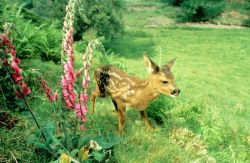Abstract
- Deer (Cervidae) populations are increasing across the temperate zone, threatening forest biodiversity and ecosystem services. However, the fundamental question of what factors make a forest susceptible to deer damage remains unanswered, hampering efforts to mitigate against damage. Previous research has assumed that deer density consistently increases forest damage. However, the effect of deer density is likely to be contingent on a range of other drivers, such as climate and landscape structure. Mitigation measures are expensive, so a sound understanding of these contingencies is required to inform the targeting of appropriate management to forests most at risk of damage.
- Using records of forest damage from Britain’s National Forest Inventory, which comprises over 15,000 plots spanning environmental gradients, we applied a multiscale approach to identify the drivers of forest susceptibility to damage by deer.
- Damage likelihood was dependent on drivers operating at multiple spatial scales and their interactions. Broadleaved stands with low tree densities and old trees were consistently found to be at high risk across Britain. The statistical influence of surrounding forest cover within 500 m of a site was modified by regional deer density and climate, in addition to landscape‐level perennial cover. The effect of deer density on damage was therefore not straightforward, but context dependent.
- Synthesis and applications. We predict the likely outcome of afforestation initiatives on the likelihood that a forest site will be damaged by deer, with important implications for management and landscape planning in Britain. The complex interactive effects uncovered are difficult to interpret. We therefore provide an interactive Deer Damage Tool (R Shiny application; https://spake.shinyapps.io/DEERDAMAGETOOL/) for practitioners to visualize how afforestation is likely to influence the probability of deer damage in different forests and regions across Britain.

